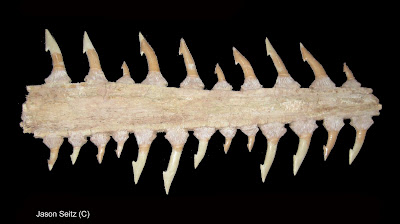By Jason Seitz.
What is all the fuss about the sawfish’s
toothy muzzle? After all, we know the sawfish
is not the only fish to have a tooth-studded nose. And we know it’s not a nose after all. It’s an extension of the skull that we are
referring to here. A snout or rostrum,
if you will. All those laterally placed
spines meet a broad definition of teeth because they are tooth-shaped, are set
into sockets (alveoli) within the cartilage of the rostrum, and are used to
secure food. The sawfish swings its
tooth-studded rostrum from side to side to stun fishes or invertebrates which
it then swallows whole.
The lateral spines along the snout
of modern sawfishes (Pristidae) are called ‘rostral teeth’ by scientists (Fig.
1). Indeed, it could be argued that these
rostral teeth are more tooth-like than are the oral teeth in sharks and rays,
as the oral teeth in these animals are not set into sockets but rather are
anchored in soft tissue. The rostrum,
like the rest of the skeleton of the sawfish, is composed of cartilage, albeit
reinforced with extra calcium. Unlike
their oral teeth, the rostral teeth are not replaced if the root becomes damaged. But as long as the roots stay healthy, rostral
teeth continue to grow and are sharpened and kept healthy by regular abrasion
with the seafloor. Sawfish that are kept
in aquaria devoid of soft sandy substrate, such as bare concrete-bottomed
tanks, often suffer from dental disease. They develop unattractive irregular pyorrhetic lesions similar to
periodontal (gum) disease in people. Captive sawfish kept in this manner over a long period of time develop
eroded portions of the rostrum adjacent to the deposits, and some rostral teeth
may even fall out or become eroded. Degenerative
invasions of the socket can develop where the teeth were lost. Thankfully, many public aquaria keeping
sawfish include a layer of sand or similar material to allow the sawfish to
maintain healthy, attractive rostral teeth.
The modern sawfish group first showed up in the fossil record between the beginning of the Cenozoic (about 66 million years ago) and the beginning of the Eocene (about 56 million years ago). The only extinct genus (Propristis) had interesting broad flat teeth that were closely spaced along the rostrum (Fig. 2).
The modern sawfish group first showed up in the fossil record between the beginning of the Cenozoic (about 66 million years ago) and the beginning of the Eocene (about 56 million years ago). The only extinct genus (Propristis) had interesting broad flat teeth that were closely spaced along the rostrum (Fig. 2).
 |
| Fig. 3: The anterior portion of a fossil rostrum and associated spines of the Cretaceous sawfish, Onchopristis numidus, Cenomanian. |
An extinct group of sawfishes occurred during the Cretaceous period, which lasted from about 145 million to 66 million years ago. Members
of the Cretaceous sawfish
group (order Sclerorhynchiformes), which are not related to modern sawfishes, had a wide variety
of shapes and sizes of rostral spines (Fig. 3). Why are we calling these rostral spines after we determined that those
of modern sawfish are called rostral teeth? The difference is that rostral spines of Cretaceous sawfishes were not
set in sockets. Their spines rested on
the surface of the cartilage of the rostrum via connective tissue and probably
were regularly replaced in the same conveyer-belt fashion as the oral teeth. Their spines ranged from closely-spaced thin
spines to widely-spaced massive barbed spines on sturdy, widened bases.
Saw sharks (Pristiophoridae) are true sharks
with spines along the rostrum similar to those of Cretaceous sawfishes (which
are rays, not sharks). The rostrum is
probably used to stun fish and invertebrate prey. Saw sharks differ from modern sawfishes in many
ways, including the fact that they possess ventrally placed rostral spines
(Fig. 4) in addition to their laterally placed spines (Fig. 5). The rostral spines are not set into sockets. Instead, the spines of saw sharks are set
within the skin and are continually replaced (rather than continually growing
but never replaced as in the modern sawfishes). There are eight species of living saw sharks, with one (Pliotrema warreni) having serrations on
its lateral rostral spines. Saw sharks
in the fossil record date back to the Cretaceous (Santonian).
The long, tooth-studded snouts of Cretaceous sawfishes, modern sawfishes, and saw sharks evolved separately and independently. Cretaceous sawfishes and modern sawfishes evolved independently from either the guitarfishes (Rhinobatidae; as suggested by some authors) or the wedgefishes (Rhynchobatidae; Fig. 6). Members of both groups have characteristics that they share with the modern sawfishes.
The long, tooth-studded snouts of Cretaceous sawfishes, modern sawfishes, and saw sharks evolved separately and independently. Cretaceous sawfishes and modern sawfishes evolved independently from either the guitarfishes (Rhinobatidae; as suggested by some authors) or the wedgefishes (Rhynchobatidae; Fig. 6). Members of both groups have characteristics that they share with the modern sawfishes.
 |
| Fig. 6: The dried head and rostrum of the whitespotted guitarfish (Rhynchobatus australiae). Note the superficial resemblance to that of modern sawfishes. |
Scientists have a name for
evolutionary adaptation in similar directions, but between different organisms,
leading to functionally similar but not identical anatomical features. They call this ‘convergent evolution’. This explains the similar snouts of modern
sawfishes, Cretaceous sawfishes, and saw sharks as these unrelated groups each
evolved their functionally and physically similar snouts separately.
In Part 2 of this series we’ll discuss paddlefish paddles, billfish bills, and swordfish….. Well, you get the idea! More anatomical oddities discussed and explained ahead so stay tuned!
In Part 2 of this series we’ll discuss paddlefish paddles, billfish bills, and swordfish….. Well, you get the idea! More anatomical oddities discussed and explained ahead so stay tuned!
Wueringer BE, Squire Jr L, Collin SP. 2009. The biology of extinct and extant sawfish (Batoidea: Sclerorhychidae and Pristidae). Reviews in Fish Biology and Fisheries 19: 445-464.
All photographs copyright of Jason Seitz.


